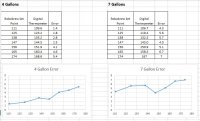Very similar for the guten as well, with the bigger malt pipe I've got a lot more headroom when it isn't full. But similar sparge I just use the pipe coming out of my water heater to trickle distribute it.Found this picture from my review. I forgot the Anvil Foundry has this plate on top with multiple holes. This obviously helped spread out the water, and controlled how quickly I could pour the sparge water so as not to overflow the shallow part of the tube.
I use that plate during the mash as well to try and stop the recirculate channelling.





